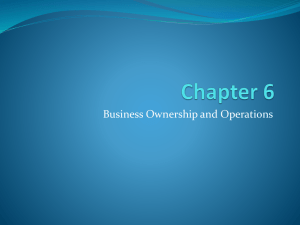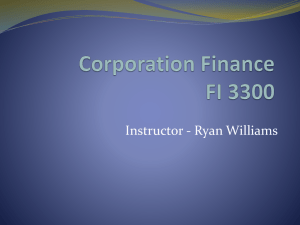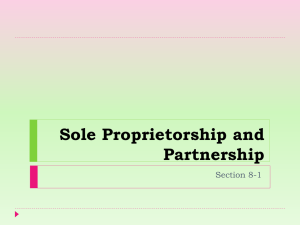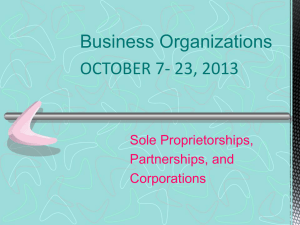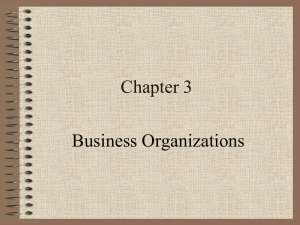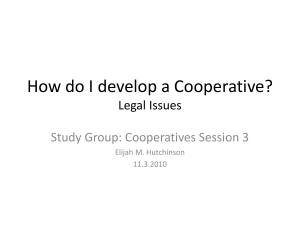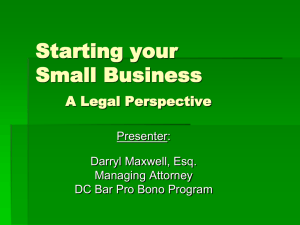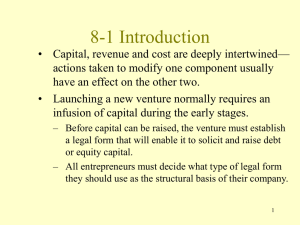Chapter 6
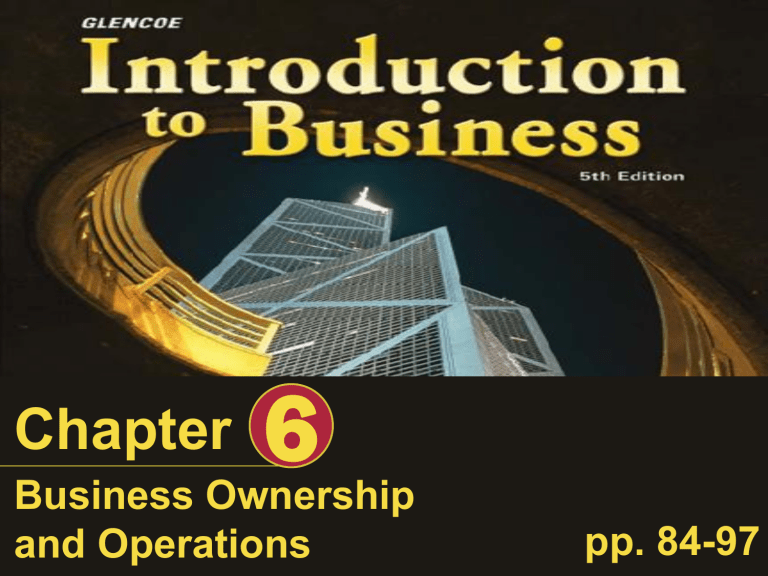
Chapter
6
Business Ownership and Operations pp. 84-97
Chapter 6
Learning Objectives
After completing this chapter, you’ll be able to:
1. Name the three forms of business ownership.
2. Compare the types of ownership.
continued
Slide 2 of 69 Introduction to Business, Business Ownership and Operations
Chapter 6
Learning Objectives
After completing this chapter, you’ll be able to:
3. Describe alternative ways to do business.
4. Identify the different types of businesses.
Slide 3 of 69 Introduction to Business, Business Ownership and Operations
Chapter 6
Why It’s Important
You need to understand business ownerships and operations before starting a business.
Introduction to Business, Business Ownership and Operations Slide 4 of 69
Chapter 6
Key Words sole proprietorship unlimited liability partnership corporation stock limited liability franchise
Introduction to Business, Business Ownership and Operations continued
Slide 5 of 69
Chapter 6
Key Words nonprofit organization cooperative producer processors manufacturers intermediaries
Introduction to Business, Business Ownership and Operations continued
Slide 6 of 69
Chapter 6
Key Words wholesaler retailer
Introduction to Business, Business Ownership and Operations Slide 7 of 69
Chapter 6
Types of Business Ownership
The three different ways you can own a business are:
•
Sole proprietorship
•
Partnership
•
Incorporation
Slide 8 of 69 Introduction to Business, Business Ownership and Operations
Chapter 6
Sole Proprietorship
A sole proprietorship is a business owned by only one person.
Introduction to Business, Business Ownership and Operations Slide 9 of 69
Chapter 6
Sole Proprietorship
The advantages to having your own business are:
• It’s easy to start
•
You get to be your own boss
•
You get to keep all the profits
•
The taxes are usually low
Slide 10 of 69 Introduction to Business, Business Ownership and Operations
Chapter 6
Sole Proprietorship
The disadvantages to having your own business are:
•
You have to pay for everything yourself
Introduction to Business, Business Ownership and Operations continued
Slide 11 of 69
Chapter 6
Sole Proprietorship
•
You might have to use your personal savings or borrow money from the bank
•
You might lack business skills
Introduction to Business, Business Ownership and Operations Slide 12 of 69
Chapter 6
Sole Proprietorship
A serious disadvantage to owning a sole proprietorship is that you have unlimited liability , or full responsibility for your company’s debts.
Introduction to Business, Business Ownership and Operations Slide 13 of 69
Chapter 6
Partnership
A partnership is a business owned by two or more persons who share the risks and rewards.
Introduction to Business, Business Ownership and Operations Slide 14 of 69
Chapter 6
Partnership
To start a partnership you need to draw up a partnership agreement, which is a contract that outlines the rights and responsibilities of each partner.
Slide 15 of 69 Introduction to Business, Business Ownership and Operations
Chapter 6
Partnership
The advantages to partnership are:
•
You might need only a license to start and have to pay taxes only on your personal profits.
•
Each of your partners can contribute money to start the business. continued
Slide 16 of 69 Introduction to Business, Business Ownership and Operations
Chapter 6
Partnership
•
Banks are often more willing to lend money to partnerships than sole proprietorships.
•
Your partners can bring different skills to the business.
Slide 17 of 69 Introduction to Business, Business Ownership and Operations
Chapter 6
Partnership
The disadvantages to partnership are:
•
You not only share the risks with your partners, you also share the profits.
Introduction to Business, Business Ownership and Operations continued
Slide 18 of 69
Chapter 6
Partnership
•
You might not get along with your partners.
•
You share unlimited legal and financial liability with your partners.
Introduction to Business, Business Ownership and Operations Slide 19 of 69
6
Similarities and Differences Between
Partnerships and Sole Proprietorships
Partnerships Both
Sole Proprietorships
Shared
Increased
Quicker decision making
Pride in owning and decision running business making
Easy to set up
Owner keeps all profits diversity of
Low taxes experience Owner is
Unlimited liability own boss
Shared losses for debts
Combined funds
Huge time demands
Relatively easy to get credit
Slide 20 of 69 Introduction to Business, Business Ownership and Operations
Chapter 6
Making an Ethical
Decision
1. What are the advantages and disadvantages of “going solo” in a business venture?
2. How can having a partner help launch and grow a business? Are there any drawbacks?
continued
Introduction to Business, Business Ownership and Operations Slide 21 of 69
Chapter 6
Making an Ethical
Decision
3. Are you obligated to invite a person into a partnership if that person was involved in inventing a product you want to sell? What if that person decided to start the business without you?
Slide 22 of 69 Introduction to Business, Business Ownership and Operations
Chapter 6
Corporation
A corporation is a business owned by many people but treated by law as one person.
Introduction to Business, Business Ownership and Operations Slide 23 of 69
Chapter 6
Corporation
To form a corporation, you need to get a corporate charter from the state your headquarters is in.
Introduction to Business, Business Ownership and Operations Slide 24 of 69
Chapter 6
Corporation
To raise money, you can sell stock , or shares of ownership in your corporation.
Introduction to Business, Business Ownership and Operations Slide 25 of 69
Chapter 6
Corporation
For each share of common stock, the stockholder gets a share of the profits and a vote on how the business is run.
You also must have a board of directors who control the corporation.
Slide 26 of 69 Introduction to Business, Business Ownership and Operations
Chapter 6
Corporation
A major advantage of a corporation is its limited liability .
If your company loses money, the stockholders lose only what they invested.
Slide 27 of 69 Introduction to Business, Business Ownership and Operations
Chapter 6
Corporation
Another advantage is that the corporation doesn’t end if the owners sell their shares.
Introduction to Business, Business Ownership and Operations Slide 28 of 69
Chapter 6
Corporation
A disadvantage of a corporation is that you often have to pay more taxes.
Introduction to Business, Business Ownership and Operations Slide 29 of 69
Chapter 6
Corporation
The government closely regulates corporations.
Introduction to Business, Business Ownership and Operations Slide 30 of 69
Chapter 6
Corporation
It is more difficult to start a corporation than a sole proprietorship or a partnership and running a corporation can be much more complicated.
Introduction to Business, Business Ownership and Operations Slide 31 of 69
Chapter 6
Figure
6.1
GENERATIONS OF FAMILY-OWNED BUSINESSES
Introduction to Business, Business Ownership and Operations
Family-owned businesses are sometimes kept in the family for more than one generation.
What percentage of families have had their family-owned businesses for two or more generations?
Slide 32 of 69
Chapter 6
Fast Review
1. What are some of the advantages of a sole proprietorship?
2. What is the difference between a sole proprietorship and a partnership? continued
Introduction to Business, Business Ownership and Operations Slide 33 of 69
Chapter 6
Fast Review
3. If a partner makes a bad business decision, what responsibility do the other partners have?
4. What are the disadvantages of a corporation?
Introduction to Business, Business Ownership and Operations Slide 34 of 69
Chapter 6
Alternative Ways to Do Business
Franchises, cooperatives, and nonprofit organizations offer you other ways to do business.
Introduction to Business, Business Ownership and Operations Slide 35 of 69
Chapter 6
Franchise
A franchise is a contractual agreement to sell a company’s products or services in a designated geographic area.
Introduction to Business, Business Ownership and Operations Slide 36 of 69
Chapter 6
Franchise
To run a franchise you have to invest money and pay the franchisor an annual fee or a share of the profits.
In return, the franchisor offers a wellknown name and a business plan.
Slide 37 of 69 Introduction to Business, Business Ownership and Operations
Chapter 6
Franchise
You can operate a franchise yourself, as a sole proprietor, as a partnership with someone else, or even as a corporation.
Introduction to Business, Business Ownership and Operations Slide 38 of 69
Chapter 6
Franchise
An advantage of opening a franchise is that it’s easy to start.
The name of the parent company can be a big draw for customers.
Slide 39 of 69 Introduction to Business, Business Ownership and Operations
Chapter 6
Franchise
The disadvantage of running a franchise is that the franchisor is often very strict about how the business is run.
Introduction to Business, Business Ownership and Operations Slide 40 of 69
Chapter 6
Nonprofit Organization
A nonprofit organization is a type of business that focuses on providing a service rather than making a profit.
Introduction to Business, Business Ownership and Operations Slide 41 of 69
Chapter 6
Nonprofit Organization
Like a corporation, a nonprofit organization has to register with the government and might be run by a board of directors.
Introduction to Business, Business Ownership and Operations Slide 42 of 69
Chapter 6
Nonprofit Organization
Because it doesn’t make a profit, a nonprofit organization doesn’t have to pay taxes.
Introduction to Business, Business Ownership and Operations Slide 43 of 69
Chapter 6
Nonprofit Organization
Donors don’t receive dividends like investors, but they can deduct their donations from their taxes.
Introduction to Business, Business Ownership and Operations Slide 44 of 69
Chapter 6
Cooperative
A cooperative is an organization owned and operated by its members for the purpose of saving money on the purchase of certain goods and services.
Slide 45 of 69 Introduction to Business, Business Ownership and Operations
Chapter 6
Cooperative
A cooperative is like a corporation in that it exists as a separate entity from the individual businesses.
Introduction to Business, Business Ownership and Operations Slide 46 of 69
Chapter 6
Cooperative
A cooperative can sell stock and choose a board of directors to run it.
Cooperatives pay less in taxes than regular corporations do.
Slide 47 of 69 Introduction to Business, Business Ownership and Operations
Chapter 6
Cooperative
Cooperatives can save money by buying insurance, supplies, and advertising as a group.
Introduction to Business, Business Ownership and Operations Slide 48 of 69
Chapter 6
Fast Review
1. What are some examples of franchise businesses?
2. What types of assistance does the franchisor give a franchisee?
Introduction to Business, Business Ownership and Operations continued
Slide 49 of 69
Chapter 6
Fast Review
3. How is a nonprofit organization like and unlike a corporation?
4. What are some advantages of a cooperative?
Slide 50 of 69 Introduction to Business, Business Ownership and Operations
Chapter 6
Manufacturing Products
Compaq Computers and Cisco Systems don’t build their own products anymore. These companies rely on Flextonics, a company that specializes in manufacturing electronics, to build their equipment.
continued
Introduction to Business, Business Ownership and Operations Slide 51 of 69
Chapter 6
Manufacturing Products
This allows Compaq and Cisco to focus on creating new products. Flextonics has grown into a global contractor that produces $10.5 billion a year in electronic gizmos.
Introduction to Business, Business Ownership and Operations continued
Slide 52 of 69
Chapter 6
Analyze
What do Compaq Computers and Cisco
Systems give up when they rely on an outside manufacturer?
Introduction to Business, Business Ownership and Operations Slide 53 of 69
Chapter 6
Types of Businesses
One way to classify businesses is to group them by the kind of products they provide:
•
Producing raw goods
•
Processing raw goods continued
Slide 54 of 69 Introduction to Business, Business Ownership and Operations
Chapter 6
Types of Businesses
• Manufacturing goods from raw or processed goods
• Distributing goods
• Providing services
Introduction to Business, Business Ownership and Operations Slide 55 of 69
Chapter 6
Producers
A producer is a business that gathers raw products in their natural state.
Raw goods are materials gathered in their original state from natural resources such as land and water.
Slide 56 of 69 Introduction to Business, Business Ownership and Operations
Chapter 6
Processors
Processors change raw materials into more finished products.
Processed goods are made from raw goods and may require further processing.
Slide 57 of 69 Introduction to Business, Business Ownership and Operations
Chapter 6
Manufacturers
Manufacturers are businesses that make finished products out of processed goods.
The finished products need no further processing and are ready for market.
Slide 58 of 69 Introduction to Business, Business Ownership and Operations
Chapter 6
Intermediaries
An intermediary is a business that moves goods from one business to another.
It buys goods, stores them, and then resells them.
Slide 59 of 69 Introduction to Business, Business Ownership and Operations
Chapter 6
Intermediaries
A wholesaler , also known as a distributor, distributes goods.
Introduction to Business, Business Ownership and Operations Slide 60 of 69
Chapter 6
Intermediaries
Wholesalers buy goods from manufacturers in huge quantities and resell them in smaller quantities to their customers, usually other companies.
Slide 61 of 69 Introduction to Business, Business Ownership and Operations
Chapter 6
Intermediaries
A retailer purchases goods from a wholesaler and resells them to the consumer, or the final buyer of the goods.
Introduction to Business, Business Ownership and Operations Slide 62 of 69
Chapter 6
Service Businesses
Service businesses provide services rather than goods.
Services are the products of a skill or an activity, such as hairstyling and car repair.
Slide 63 of 69 Introduction to Business, Business Ownership and Operations
Chapter 6
Service Businesses
Some service businesses meet needs, such as medical clinics and law firms.
Some provide conveniences, such as taxi companies and copy shops.
Slide 64 of 69 Introduction to Business, Business Ownership and Operations
Chapter 6
Fast Review
1. What is the difference between a producer and a processor?
2. What does a manufacturer do with raw or processed goods?
Introduction to Business, Business Ownership and Operations continued
Slide 65 of 69
Chapter 6
Fast Review
3. What does an intermediary do?
4. Give examples of service businesses.
Slide 66 of 69 Introduction to Business, Business Ownership and Operations
Chapter 6
What’s the aim of joining forces and starting an organization?
What’s the benefit of going into business for yourself?
continued
Introduction to Business, Business Ownership and Operations Slide 67 of 69
Chapter 6
Can a business have a contractual agreement with its customers?
Introduction to Business, Business Ownership and Operations Slide 68 of 69
End of Chapter
6
